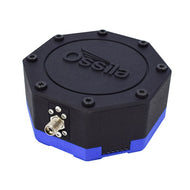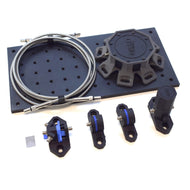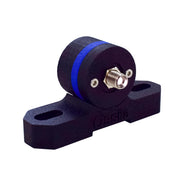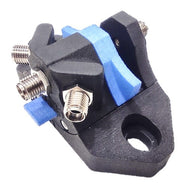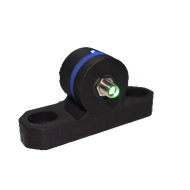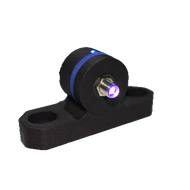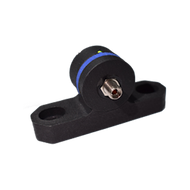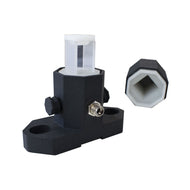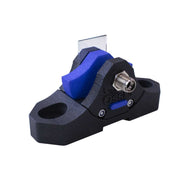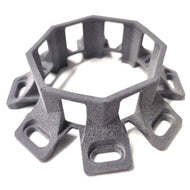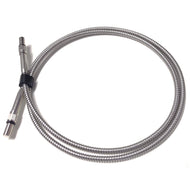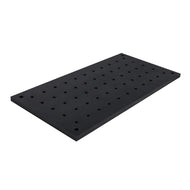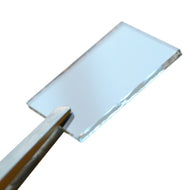Spectrometer Optics
A spectrometer can be designed and built with a variety of optical configurations. These include the Littrow configuration, the Ebert-Fastie configuration, the Czerny-Turner configuration, and the concave aberration-corrected holographic grating configuration. Careful choice of components and configuration can avoid aberrations, which result in distorted or blurred spectra.
Optical Spectroscopy Kit

- Excellent Value
- Precision Optics
- Free Software + Updates
Worldwide Delivery £2400
Optical Configurations
Littrow Configuration
The Littrow configuration is the simplest design utilising a plane reflection grating. Although it is not commonly found in spectrometers today, it is still used to characterise diffraction gratings.
This configuration consists simply of a spherical mirror and a plane grating. The light enters the spectrometer through an entrance slit and is collimated by the mirror. The reflected light is then incident on the diffraction grating, as is shown below. The diffraction order of interest is directed back towards the mirror, where it is reflected towards the exit slit, which is spatially very close to the entrance slit.

Although this configuration has a very high wavelength resolution, the risk of stray light, internal reflections and multiple dispersions is significant.
Ebert-Fastie Configuration
The Ebert spectrograph was first described by Hermann Ebert in 1889. After many decades of relative obscurity, the design was resurrected by William G. Fastie in 1952, who included curved slits to remove astigmatism (see 'Aberrations present in spectrometers') and reduce wavelength errors at the exit slit [1].
The Ebert-Fastie (sometimes referred to as Fastie-Ebert) configuration is composed of a large spherical mirror and a single plane diffraction grating. The light enters the spectrometer through the circularly curved entrance slit and is incident on one portion of the mirror, as illustrated below. The mirror directs the now-collimated light onto the plane grating and the diffracted light is then reflected from a second, separate portion of the mirror. The light reflected from the mirror is then focused through the circularly curved exit slit, after which point it is collected by the detector. Here, the angle between the incident and reflected rays, a, is the same for both reflections from the mirror [2].
Limitations of the Ebert-Fastie configuration include the risk of light being reflected directly from the mirror towards the exit slit without being diffracted and of multiple diffractions.

Czerny-Turner Configuration
Quite similar in design to the Ebert-Fastie configuration, the most common design used in spectrometers today is the Czerny-Turner configuration. First described in 1930 by M. Czerny and A.F. Turner, the design has since been altered to remove and reduce certain aberrations and has several advantages over the Ebert-Fastie configuration [2].
Instead of a single large spherical mirror, the Czerny-Turner configuration uses two smaller spherical mirrors, as depicted below. Here, the light enters the spectrometer through the entrance slit and is reflected from the first spherical mirror onto a plane diffraction grating. The dispersed light is then reflected by the second mirror and is collected by the detector on the other side of the exit slit.
In Czerny-Turner configurations, the mirrors do not have to be the same size or placed the same distance from the slits or the diffraction grating. They can even have different radii of curvature. In addition, the reflection angles for the two mirrors, a and b, do not have to be equal and the grating can even be "off-axis", i.e., the distances xa and xb can be different [3].

This configuration does not allow light to be directly reflected from the entrance to the exit slits, which reduces unwanted reflections and multiple dispersions compared to the Ebert-Fastie configuration. The asymmetrical design allows for better coma correction and a flattened spectral field compared to the symmetrical version (see aberrations).
It is possible to fabricate holographic gratings to include physical aberrations that cancel out all optical aberrations at a particular wavelength and drastically reduce them for a large range of wavelengths [4].
Concave Aberration-Corrected Holographic Grating Configuration
Instead of a plane grating, it is also possible to fabricate concave holographic gratings that correct for optical aberrations. In this case, the diffraction grating is the only optic needed: the light enters the spectrometer through the entrance slit and is diffracted by the grating, which focuses the light onto the exit slit.

As only a grating is needed for this configuration, errors due to multiple reflections, imperfect mirrors, and thermal effects are reduced. A higher signal-to-noise ratio is also possible due to decreased reflection losses. This design is simple to align, inexpensive and compact.
Spectrometer Aberrations
There are several different types of aberration present in spectrometers that can cause images and spectra to be distorted or blurred. It is possible to significantly reduce the effect of these aberrations using specific components and configurations. In general, mirrors (and gratings) are used for collimation instead of lenses as they result in a much lower degree of aberration. However, certain aberrations can still arise.
Spherical aberration
Spherical aberration arises when rays are reflected from a spherical surface, for example, a spherical mirror. When collimated light rays are incident far from the optical axis (the centre) of the mirror, the reflected rays are focused closer to the mirror surface than those that were incident on or near the optical axis. This is illustrated in the figure below (where it should be noted that the different colours are simply for ease of viewing and do not correspond to different wavelengths/colours of light).
Spherical aberration can be avoided by using parabolic mirrors; however, these are more difficult to make and therefore more expensive.

Coma
A point source — for example, a star — as viewed through a telescope with comatic aberration will appear to have a comet-like tail; hence, the term "coma". This is due to the fact that when parallel rays are incident at an angle to the optical axis of a spherical mirror, the reflected rays do not have a common focus. This is illustrated in the left-hand figure below (where it should be noted that the different colours are for ease of viewing and do not correspond to different wavelengths/colours of the rays) and results in a blurred image. In a spectrum, coma appears as an increased signal on one side of a spectral feature, i.e., an asymmetrical broadening, as illustrated in the right-hand side of the figure below.

In Czerny-Turner spectrometers, it is possible to completely eliminate coma at one wavelength and using a concave aberration-corrected holographic grating configuration, it can be eliminated at a wide range of wavelengths.
Astigmatism
Astigmatism also occurs during the off-axis illumination of a spherical mirror. Here, the rays in the horizontal (transverse) and vertical (sagittal) planes are focused on different points. This is illustrated in the figure below, where it can be seen that the rays in the horizontal plane are focused closer to the mirror than in the vertical plane. This effect results in an elongation of the image and can lead to a loss in spatial resolution and signal-to-noise ratio in a spectrometer.

Astigmatism can be avoided by using curved slits, as in the Ebert-Fastie configuration, or an aberration-corrected grating [1]. It can also be removed by replacing spherical mirrors with toroidal ones; however, these are still affected by coma and spherical aberration.
Spectrometer and Accessories

- Low Price Optical Spectrometer
- Light Sources
- And More
Complete Kits for £2400
References
- W.G. Fastie, "Ebert Spectrometer Reflections", Physics Today 44(1), 37 (1991)
- W. Neumann, "Fundamentals of Dispersive Optical Spectroscopy Systems", SPIE (2014)
- G. Wünsch, A. Wennemer, J.W. McLaren, "On the design and performance of the Czerny-Turner monochromator in ICP-AES", Spectrochimica Acta Part B: Atomic Spectroscopy, 46(11), 1517-1531 (1991)
- A. Thevenon, et al., "Aberration-Corrected Plane Gratings", Proceedings of SPIE, 0815, 136-145 (1987)
Contributing Authors
Written by
PhD Student Collaborator
Reviewed by
Product Specialist
Application Scientist
Related Products
